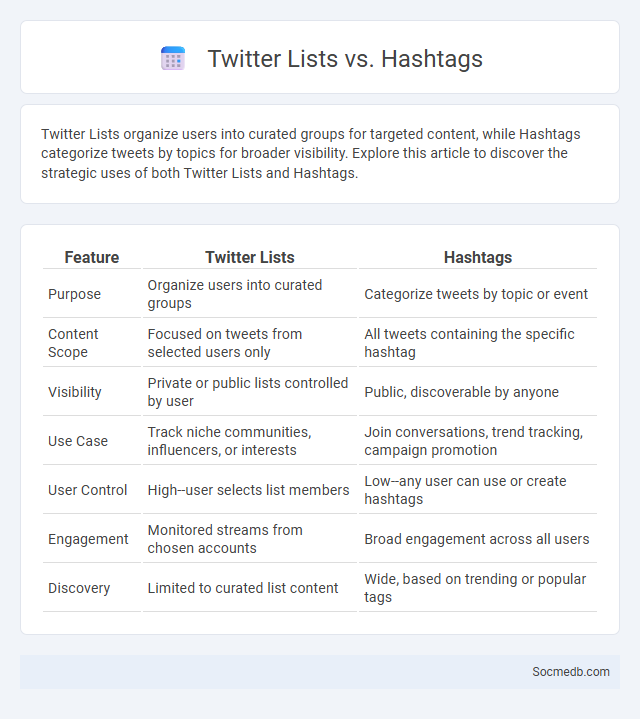
Photo illustration: Twitter List vs Hashtags
Twitter Lists organize users into curated groups for targeted content, while Hashtags categorize tweets by topics for broader visibility. Explore this article to discover the strategic uses of both Twitter Lists and Hashtags.
Table of Comparison
| Feature | Twitter Lists | Hashtags |
|---|---|---|
| Purpose | Organize users into curated groups | Categorize tweets by topic or event |
| Content Scope | Focused on tweets from selected users only | All tweets containing the specific hashtag |
| Visibility | Private or public lists controlled by user | Public, discoverable by anyone |
| Use Case | Track niche communities, influencers, or interests | Join conversations, trend tracking, campaign promotion |
| User Control | High--user selects list members | Low--any user can use or create hashtags |
| Engagement | Monitored streams from chosen accounts | Broad engagement across all users |
| Discovery | Limited to curated list content | Wide, based on trending or popular tags |
Introduction to Twitter Lists and Hashtags
Twitter Lists organize users into curated groups, enabling you to streamline content and monitor specific topics efficiently. Hashtags categorize tweets under relevant themes, increasing visibility and engagement within targeted communities. Leveraging both tools optimizes your social media strategy by enhancing content discovery and audience interaction.
What Are Twitter Lists?
Twitter Lists are curated groups of Twitter accounts, allowing users to categorize and organize content based on specific interests or themes. By creating or subscribing to lists, you can streamline your Twitter feed to focus on relevant updates without the distraction of unrelated posts. This feature enhances your ability to monitor industry news, follow expert opinions, and engage with targeted communities efficiently.
Understanding Twitter Hashtags
Twitter hashtags serve as powerful tools for categorizing content, making tweets discoverable to a broader audience interested in specific topics. Effective use of relevant and trending hashtags can significantly enhance engagement and increase visibility on the platform. Analyzing hashtag performance through Twitter analytics helps users refine their social media strategy for maximum reach and impact.
Key Features: Lists vs. Hashtags
Social media platforms utilize lists and hashtags as key features to organize content and enhance user engagement. Lists allow users to categorize accounts or topics for streamlined content consumption, improving personalized feed management. Hashtags function as searchable keywords or phrases, enabling broader content discovery and participation in trending conversations.
Use Cases for Twitter Lists
Twitter Lists enable users to organize accounts into customized groups, improving content curation and real-time monitoring. Brands and marketers utilize Twitter Lists to track industry influencers, competitors, and customer feedback efficiently. Journalists and researchers leverage Lists to follow topic-specific experts, enhancing news gathering and trend analysis.
Best Practices for Using Hashtags
Using relevant and specific hashtags increases your content's visibility and engagement on social media platforms. Research trending and niche hashtags within your industry to reach your target audience effectively. Ensure your hashtags are concise and avoid overloading your posts to maintain clarity and professionalism for your brand.
Advantages of Organizing with Lists
Organizing social media content with lists enhances user engagement by presenting information in a clear, concise format that is easy to skim and remember. Lists improve content discoverability and SEO performance by incorporating relevant keywords and structured data. This method also boosts shareability, increasing the likelihood of content spreading across platforms and reaching a broader audience.
Discoverability: Lists vs. Hashtags
Hashtags enhance social media discoverability by categorizing content across platforms, making posts searchable to users beyond direct followers. Lists, often used on platforms like Twitter, organize specific users into groups, allowing targeted content curation but limiting broader content discovery. Prioritizing hashtags increases visibility to a wider audience, while lists offer focused engagement within defined communities.
Managing Engagement: Lists and Hashtags
Managing engagement on social media involves strategically using lists and hashtags to organize and target your audience effectively. You can increase your visibility and interaction by joining relevant hashtag conversations and creating custom lists to monitor specific user groups or topics. Utilizing these tools helps streamline content curation and fosters meaningful connections within your digital community.
Choosing the Right Tool: Lists or Hashtags?
Choosing the right social media tool between lists and hashtags depends on your content strategy and audience engagement goals. Lists help organize and target specific groups or topics for curated content delivery, enhancing personalized interactions. Hashtags increase content discoverability and foster community participation by linking posts to broader conversations and trending themes.
 socmedb.com
socmedb.com